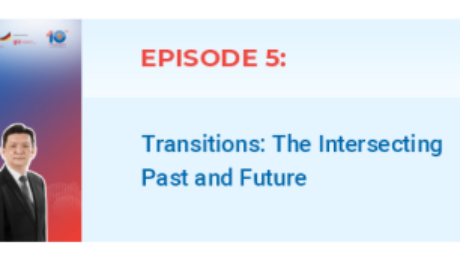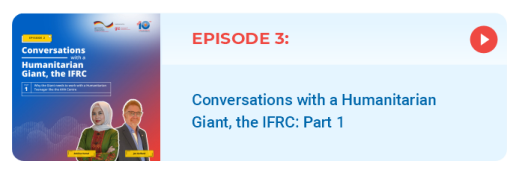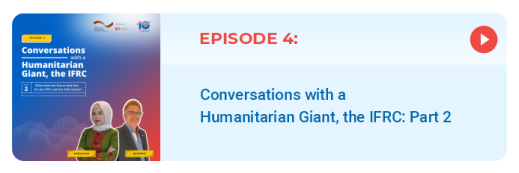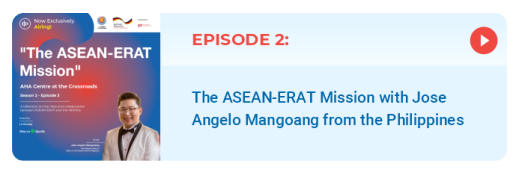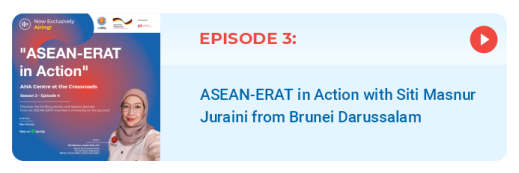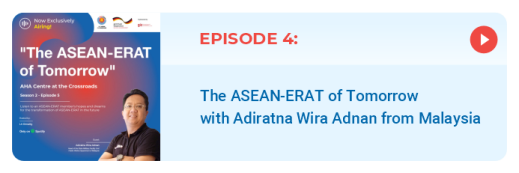
BUILDING RESILIENCE
OF WOMEN AND OTHER VULNERABLE GROUPS THROUGH CAPACITY BUILDING
Background of the Project
The project ‘Improving ASEAN’s Humanitarian Assistance Capacity in Multi Hazard’ – funded by the Government of Canada (Global Affairs’ Canada) – launched in April 2022, will run for five years, from 2022 – 2027.
One of the guiding principles of the ASEAN Agreement on Disaster Management and Emergency Response (AADMER) Work Programme 2021 – 2025 is on Gender and Inclusion. This principle inculcates a whole-of-society approach in disaster management that leaves no one behind by recognizing the key roles and unique needs of the communities, especially those that are most affected during disasters, including women and other vulnerable groups. As one of the implementors of the AADMER Work Programme 2021 – 2025, the AHA Centre proposed this project to further expand the capacity of ASEAN Member States and Local Partners through a multi-sectoral approach to systematically integrate such gender and protection considerations into disaster management.
Through this project, the AHA Centre supports ASEAN Member States and Local Partners to recognize and set the priorities for indicators and targets related to protection, gender, and inclusiveness (PGI). This project believes that building resilience of women, and other vulnerable groups within the national and regional resilience will help in addressing and mitigating socio-economic impact of the disasters.
The Project adopts the AADMER Work Programme 2021-2025 and formulized the ASEAN Regional Framework on Protection, Gender, and Inclusion in the ASEAN Region. Subsequently, a new AADMER Technical Working Group on Protection, Gender, and Inclusion (TWG-PGI) was established in 2021 to support the mainstreaming of the gender and social inclusion guiding principles throughout the disaster management efforts in the region.
Main Components of the Project
The Project has three main components, among others, (i) Enhanced Regional Coordination Mechanism to respond to multiple types of disasters, which integrates PGI, Climate Change Adaptation and Environmental Sustainability measures; (ii) Improved Knowledge of ASEAN responders in addressing the needs and interests of vulnerable groups during emergency periods; and (iii) Improved disaster management and emergency response practices in ASEAN Member States.
Upcoming activities of 2023
As of February 2023,
the Canada Project had its first series of activities—Exchange Forum on ASEAN’s Practices on Data Disaggregation in Disaster Management: A Way Towards Protection, Gender, and Inclusiveness (PGI), and the 1st Project Steering Committee (PSC) Meeting of the Project, which were held in Da Nang, Viet Nam on 22-24 February 2023. The PGI Exchange Forum is designed to help participants exchange knowledge on PGI experiences, which will be a key principle for the achievement of this project. The PGI Exchange Forum and the 1st PSC Meeting were held back-to-back with the 5th Meeting of the Technical Working Group on Protection, Gender and Inclusion (TWG-PGI), and 5th Meeting of the ASEAN Committee on Disaster Management Working Group on Prevention and Mitigation (ACDM WG P&M).
Starting Quarter 2 of 2023 (April – June),
the project aims to conduct Consultation and Desk Review on expanding the existing New Risk Scenario. This activity falls under the outcome of “Enhancing Regional Coordination Mechanism to respond to multiple types of disaster which integrates PGI, Climate Change Adaptation and Sustainability measures”. Within this activity, the project aims to develop a new Disaster Risk Scenario Study, adding to the three existing scenarios in the ASEAN Joint Disaster Response Plan (AJDRP). The new Disaster Risk Scenario will focus on Transboundary Flood within the Mekong sub-region. Additionally, the scenario will integrate PGI, Climate Change Adaptation and Environmental Sustainability as part of the Project’s key thematic areas.
In Quarter 3 of 2023 (July – August),
the project intends to organize consultation workshops to validate the New Risk Scenario. Within the same quarter, the project further aims to conduct Capacity Building on PGI, focusing on the exchange of experiences among ASEAN Member States through cross-learning.
In the last Quarter 4 of 2024 (October – December),
the project aims to deploy experts from the Member States to other Member States as part of Capacity Development Support.
Canada’s Support
The Project Management Team has been recruited in Jakarta, Indonesia, and have begun their work alongside the Disaster Monitoring & Analysis Team (DMA) in the AHA Centre. The Team is currently made up of a Project Officer and Project Assistant, who will implement the project’s activities and strategy with support from the Government of Canada and experts from the AHA Centre’s partners, including UNWOMEN, LACER, and SDC.
This forms an exciting journey for the AHA Centre and the ASEAN Member States to ensure this initiative further contributes to the envisions of AADMER Work Programme 2021-2025. The AHA Centre, through the Canada-funded project, looks forward to working closely with the Government of Canada, NDMOs, ASEAN Member States, The ASEAN Secretariat, and AHA Centre partners, to integrate PGI, CCA, and ES into the efforts of increasing capacity, enhancing standby arrangement with new disaster scenario, and further increasing collaboration and partnership will increase resiliency of multiple types of disasters within AMS and Local Partners.
Written by: Pwint Mon Swe, Htet Wai Zin, Lawrence Anthony Dimailig

AHA CENTRE PODCAST SERIES:
AT THE CROSSROADS
The AHA Centre, with support from Deutsche Gesellschaft für Internationale Zusammenarbeit GmbH (GIZ), worked to broaden its communications and outreach, including on social media. One of the results of this cooperation was a series of podcasts released in mid-2021 as part of the AHA Centre’s 10th Anniversary celebration. The podcast series entitled “AHA Centre at the Crossroads” involved discussions with the AHA Centre’s founders, builders, colleagues and partners, and discussed the AHA Centre’s 10-year journey from inception to transition. The guests described their experiences in working together with the Centre and expressed their hopes for the future in the next decade of action.
The first season is already airing and accessible at the AHA Centre’s Spotify channel – AHA Centre at the Crossroads. Meanwhile, the second season focused on sharing experiences from members of the ASEAN Emergency Response and Assessment Team (ASEAN-ERAT) as ASEAN’s rapid response team and was released in February 2023.
In the second season, four ASEAN-ERAT members from Thailand, Philippines, Brunei Darussalam, and Malaysia shared their experiences of becoming ASEAN-ERAT members, particularly when the were deployed to the disaster affected countries. Being deployed to different countries has always been a challenge for them. Not only conducting rapid needs assessment in the affected areas, but the ASEAN-ERAT members also need to understand the culture and other social aspects.
The AHA Centre Podcast has become an alternative channel for the AHA Centre to communicate to its partners and stakeholders on various topics in this digital era.
SEASON 1
SEASON 2
Written by: Moch Syifa

MONTHLY DISASTER REVIEW AND OUTLOOK
MAY 2023 | DISASTER MONITORING & ANALYSIS
(DMA) UNIT, AHA CENTRE
GENERAL REVIEW OF MAY 2023
For the month of May 2023, a total of 88 disasters were reported. The ASEAN Member States that were affected are Indonesia, Myanmar, the Philippines, Thailand, and Viet Nam. Most of the disasters (70%) occurred in Indonesia but only accounted for 8% of the affected persons (around 154,000). Notably, Myanmar accounted for most of the affected persons despite reporting only 1 disaster event—Tropical Cyclone MOCHA with 63% of the total reported affected persons for the month of May. The share of the disaster-affected people for the other ASEAN Member States are as follows: (1) Philippines-11%, (2) Thailand-18.12% and (3) Viet Nam-0.03%. May 2023 saw disasters affecting 284 per 100,000 people* and displacing 137 per 100,000 people* in the region, which were 3 times and 15 times higher respectively compared to the previous month.
Most of the disasters that have occurred in May 2023 are floods (51%) and is consistently the most recorded type of disaster for May of the previous year and May on a five-year average (2018-2022). The reported disasters in the region for May 2023 in comparison to the historical data (average for May 2018-2022) indicates that there were about 1.4x more reported disasters; 4.8x more people affected; 66x more people internally displaced; 7x more houses affected to some extent; 27x more lives lost; and 3.5x less people suffering injuries;.
Geophysically, 24 significant earthquakes (Magnitude ≥ 5.0) were reported by Indonesia’s Badan Meteorologi, Klimatologi dan Geofisika (BMKG), Thailand Meteorological Department (TMD), and the Philippine Institute for Volcanology and Seismology (PHIVOLCS).
Mount Semeru (Alert Level III), Anak Krakatau (Alert Level III), Ili Lewotolok (Alert Level II), Dukono (Alert Level II), and Ibu (Alert Level II) in Indonesia and Taal (Alert Level 2) and Kanlaon Volcanoes (Alert Level 1) were reportedly tectonically active (erupting lava or releasing gas or generating seismic activity) throughout the month of May 2023.
*computed based on 2023 population data from worldometers.com
ANALYSIS
According to the ASEAN Specialised Meteorological Centre (ASMC), compared to the average value from 2001-2022, during May 2023, less to near-average rainfall was experienced in Mainland Southeast Asia but more to near-average for the Maritime Continent. The largest difference (driest condition) from the average rainfall was observed over southern Myanmar and southern Thailand. Despite these dry conditions detected over Myanmar, a MAJOR disaster was caused by Tropical Cyclone MOCHA in its western and northwestern regions. As shown in Figure 1.a and 1.b, despite majorly exhibiting drier conditions, the areas within the track of cyclone MOCHA exhibited drier than normal conditions.
SEASONAL OUTLOOK
According to the ASEAN Specialised Meteorological Centre (ASMC), Southwest Monsoon conditions are expected to be established from June 2023 and persist until August 2023. These conditions traditionally bring rain often resulting in widespread and persistent shower activities in the northern ASEAN region. Over the southern ASEAN region, the Southwest Monsoon seasons is characterised by drier conditions compared to other times of the year, as the monsoon rain band typically lies further north from the Equator.
For the next 3 months, (June-July-August 2023), an increased chance of below-normal rainfall is predicted for much of the southern ASEAN region, with highest likelihood over the southern Maritime Continent. ENSO neutral conditions are present but will likely transition into El Nino in the next few months. Warmer-than-normal temperature is predicted for much of the ASEAN region.
Note: The qualitative outlook is assessed for the region in general and based on the latest runs from models provided by the SEA RCC-Network LRF node. For specific updates on the national scale, the relevant ASEAN National Meteorological and Hydrological Services should be consulted.
Sources: ASEAN Disaster Information Network (ADINet), ASEAN Disaster Monitoring and Response System (DMRS), ASEAN Specialised Meteorological Centre (ASMC), Badan Nasional Penanggulangan Bencana (BNPB) – Indonesia, Agensi Pengurusan Bencana Negara (NADMA) – Malaysia, Department of Disaster Management (DDM) – Myanmar, National Disaster Risk Reduction and Management Council (NDRRMC) – Philippines, Department of Disaster Prevention and Mitigation (DDPM) – Thailand, Thai Meteorological Department (TMD) – TMD, Badan Meteorologi, Klimatologi dan Geofisika (BMKG) – Indonesia, Pusat Vulkanologi dan Mitigasi Bencana Geologi (PVMBG) – Indonesia, Philippine Institute for Volcanology and Seismology (PHIVOLCS) – Philippines, Philippine Atmospheric Geophysical and Astronomical Services Administration (PAGASA) – Philippines
Written by : Keith Paolo Landicho, Sadhu Zukhruf Janottama, Lawrence Anthony Dimailig
DISCLAIMER
The AHA Centre’s estimation is based on data and information shared by National Disaster Management Organisations (NDMOs) and other relevant agencies from ASEAN Member States, international organisations, and news agencies. Further information on each recorded significant disaster, description, and detail of data and information are available at: https://adinet.ahacentre.org/report/

ROAD TO ARDEX-23:
FINAL EXERCISE PLANNING TEAM (EPT) MEETING AND REFEREE TRAINING FOR THE ASEAN REGIONAL DISASTER EMERGENCY RESPONSE SIMULATION EXERCISE 2023
The Final Exercise Planning Team (EPT) Meeting and Referee Training for the ASEAN Regional Disaster Emergency Response Simulation Exercise 2023 (ARDEX-23) recently took place from 8 to 11 May 2023 in Yogyakarta, Indonesia.
Hosted by the National Disaster Management Authority of Indonesia (BNPB) and the AHA Centre, as co-organisers, the Final EPT Meeting served as a continuation of the First EPT Meeting held in February 2023. During this gathering, the ASEAN Member States, BNPB Indonesia, AHA Centre, ASEAN Secretariat, and other stakeholders convened to solidify the Master Scenario Events List (MSEL), determine the level of participation from ASEAN Member States, establish the exercise control team structure, and make necessary logistics arrangements. These crucial elements are vital to ensuring the success of ARDEX-23, as they lay the foundation for effective coordination and response during the exercise. Held on 8-9 May 2023, the Meeting was officially opened by Deputy Minister of Logistics and Equipment of BNPB Indonesia Dr. Lilik Kurniawan, ST., M.Si.
Following the EPT Meeting, on 10-11 May a Referee Training session was conducted to define the roles and responsibilities of referees, and to standardise the evaluation process, and equip Referees with the necessary tools and provided with guidance to fulfil their tasks effectively, guaranteeing a seamless exercise. The Referees will play a crucial role during ARDEX-23, closely observing the exercise at both the Strategic and Operational Levels in order to gain insights that will serve as valuable references and planning parameters for future ARDEX exercises.
With the goal of testing and evaluating ASEAN’s emergency response and disaster management mechanisms, ARDEX is a full-scale simulation exercise that aims to enhance regional coordination and strengthen disaster resilience. The event, scheduled to be held from 31 July to 4 August 2023 at the Sultan Agung Stadium in Bantul, is expected to mark another significant milestone in the ASEAN calendar. Supported by the European Union through EU-SAHA, ARDEX-23 is poised to reinforce national and regional preparedness while facilitating a collaborative response to disaster emergencies.
ARDEX-23 holds significant importance in strengthening national, regional, and international coordination to achieve disaster resilience. Through the comprehensive testing, practising, reviewing, and evaluating of ASEAN’s emergency response and disaster management mechanisms, including the SOPs for the Coordination of EMTs, MNCC, and the ASEAN Militaries Ready Group on Humanitarian Assistance and Disaster Relief (AMRG on HADR), this regional exercise aims to enhance coordination capacity and preparedness. ARDEX exercises, which are conducted regularly every two years, have become key events in the ASEAN calendar and continue to contribute to the region’s disaster resilience efforts.
With ARDEX-23 on the horizon, the AHA Centre, BNPB Indonesia, ASEAN Member States, and stakeholders are gearing up to prepare for this vital regional exercise. As ARDEX continues to evolve, it reinforces the importance of preparedness and collaboration in effectively handling disaster emergencies in the ASEAN region and beyond.
Written by: Moch Syifa, Gladys Respati | Photo credits: AHA Centre




